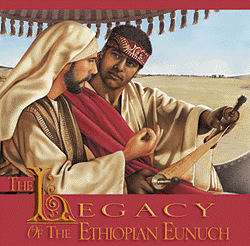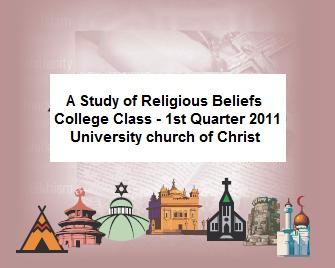Home | About Us | Directions | Bulletins | Sermons & Audio | Cross Of Christ Studies | Classes | Student and Parent Resource Page | Dangers Facing the "Non-Traditional"
Genesis 3:15 and the Seed Promise
by Doy Moyer
Genesis 3:15 is addressed to the devil after he deceived Eve. Yahweh is cursing him, and in doing so provides a basic framework for understanding the Scriptures from that point forward. How we understand Genesis 3:15 greatly affects how we understand the rest of the Bible and human history. How is this so? First, we will begin with the interpretation, then attempt to demonstrate how it affects our understanding of the rest of Scripture.
Levels of Enmity
Because the devil, in the form of the serpent, tempted and deceived Eve, the Lord tells him, “I will put enmity between you and the woman.” Enmity is the idea of hostility to the point of desiring to kill. The devil’s hatred for humanity is clearly seen in this. Jesus pointed out to the Pharisees, as they behaved like the devil, that Satan was a murderer from the beginning (John 8:44). Satan’s intent with the woman in Genesis 3 was not to make her happy somehow; his intent was to kill. If she ate of the fruit, she would surely die, as God had promised. Her acceptance of Satan’s lie resulted in her death. He was successful in his desire on that occasion. This sets the stage for how the devil operates and thinks toward humanity. He hates (has enmity toward) humanity and desires to kill. This is a first level enmity in that it deals directly with Satan’s confrontation with Eve and, by extension, every individual. That is, the devil has already demonstrated enmity toward the woman, and from that point on he would continue to show such enmity toward all mankind. He wants all of us to suffer death.
The second level of enmity, according to Genesis 3:15, is “between your seed and her seed.” “Seed” refers to offspring. Since the devil does not physically have children, we would conclude that this refers to spiritual offspring. That is, the seed of the serpent refers to all who follow the ways of the devil. “The one who practices sin is of the devil” (1 John 3:8). Again, in Jesus’ rebuke to the Pharisees, He pointedly said, “You are of your father the devil, and you want to do the desires of your father” (John 8:44). They were demonstrating an attitude like that of the devil, so it was appropriate to say that the devil was their “father.” They thought of themselves as the seed of Abraham, but hardly displayed the faith of Abraham. Instead, they were the seed of the serpent.
If the seed of the serpent refers to the spiritual offspring of the devil, the seed of woman refers to the spiritual offspring of God. That is, these are the ones who follow the will of God and seek to please Him. To drive this home, John uses the language of Genesis 3:15 to discuss warfare between Satan, his forces and the Lord’s people (Rev. 12). The dragon (Satan) waged war on the woman (demonstrating the enmity), “and went off to make war with the rest of her children, who keep the commandments of God and hold to the testimony of Jesus” (Rev. 12:17). The children of the woman here are defined as those who keep the commandments of God. Those who have the seed of God in them are His children (1 John 3:9).
The above points argue that the second level of enmity is between those who serve the devil and those who serve God. The spiritual offspring of Satan wage war (demonstrate enmity) against the offspring of God. The direct verbal prophecy of Genesis 3:15, then, is a prophecy about warfare between the righteous and the unrighteous. The fulfillment of this in Scripture is relatively obvious.
The third level of enmity in Genesis 3:15 gets even more specific. Whereas there is enmity between Satan’s offspring and God’s offspring, the prophecy was that it would culminate in the battle between two individuals: “He shall bruise you on the head, and you shall bruise him on the heel.” The “you” of this verse is Satan, since it is he whom the Lord is addressing. The question is, who is the “He” of this passage? “He” is more personal than “the offspring of God” in a general sense. God had in mind one particular person through whom the works of the devil would be destroyed. From this point in the Bible, not only would God’s people be constantly at war with the unrighteous, but God would oversee history in such a way that He would bring about a plan through which His Messiah would free His people from sin and “crush” the power of the devil. This was fulfilled in Jesus Christ, whose purpose in coming to the earth was to “destroy the works of the devil” (1 John 3:8). This is emphasized by the Hebrew writer when he affirmed that “through death He might render powerless him who had the power of death, that is, the devil” (2:14). This is the idea behind the statement, “He will crush your head.” While it appeared that the devil had won for a short time (the heel bruise), the resurrection of Jesus rendered Satan’s power ineffectual (the head bruise). The heel bruise would not be a mortal and final blow, but the head bruise would be.
Genesis 3:15, then, is a foundational statement regarding God’s redemptive purposes and plans. It is a direct verbal prophecy that has an impact on the history of both Israel and all mankind. In such a brief message, God establishes the enmity between Satan and mankind, Satan’s spiritual offspring and God’s spiritual offspring, and Satan and Christ. Yet, in this verse, God provides a glimmer of hope for fallen mankind. While God could have wiped out mankind right then, He chose rather to institute His plan to bring mankind back into fellowship with Him through Jesus His Son. It would be a plan that would take years to bring about (i.e., “the fullness of the times”), but it would unquestionably show God’s love, grace, mercy, and even wrath. So now we need to back up and see how this happens.
Genesis 3:15 and the Historical Books
How does this interpretation of Genesis 3:15 affect our understanding of the historical books? First, it gives us the basic framework for seeing how God is bringing about the fulfillment of His redemptive promises. We are not simply reading a bunch of disconnected events and stories. We are seeing a flow throughout Scripture; we are seeing God’s hand in the history of His people as He, in His sovereignty, brings about the fullness of the times in which Jesus would enter the world. By coming into the world, dying on the cross, and being raised again, we find the fulfillment of the heel bruise to Christ and the head bruise to the devil. The story of the Bible is this story, and Genesis 3:15 lays the groundwork for it.
Even before getting to the historical books, the Pentateuch, which itself contains important history to this interpretation, shows the enmity existing between God’s people and the unbelievers. Immediately after Genesis 3, Cain murders Abel. Why? John explains that Cain was “of the evil one” (i.e., the seed of the serpent), and “his deeds were evil” (1 John 3:12). Abel, a righteous man, was the seed of woman (cf. Heb. 11:4). So immediately there is an example of the second-level enmity between the righteous and the unrighteous. This same pattern follows throughout Genesis, through the Pentateuch, and into the historical books of the Old Testament. In Genesis, the emphasis is mostly upon individuals playing out their roles in this plan. In Exodus, the emphasis shifts from individuals to nations, focusing first upon Israel (the seed of woman) versus Egypt (the seed of the serpent). The enmity shown by Egypt toward Israel is apparent in how the Egyptians treated the Israelites.
God spoke to Abraham and narrowed the focus of His plan concerning the ultimate Seed (Gen. 12:1-3). The Seed, which would now come through Abraham, would result in all the nations of the earth being blessed. The apostles inform us that this particular seed promise was fulfilled in Jesus Christ, and the blessing is found in forgiveness: “turning every one of you from your wicked ways” (Acts 3:26). From Genesis 12 on, focus is on the lineage of Abraham, Isaac, and Jacob, as being the heirs of the promises of God. God would make of them a great nation, bring them into the Promised Land, and ultimately bring about the Seed (Messiah) through whom forgiveness could be found. By coming to the Seed, we become the seed of woman, with God’s seed abiding in us.
It is my view that the nation and land promises were a means to the end of bringing about the seed promise. In order to bring this promise about, God funneled history through the nation of Israel, bringing them to their own land in order to keep them pure. By doing this, He directed the conditions for bringing about the seed promise. The land and nation promises were not ends all to themselves. God had a greater purpose in that these facilitated the ultimate promise concerning Jesus Christ, the seed. In other words, the seed is the focal point throughout the Scriptures.
After Israel left Egypt, God brought them to Sinai where He gave them the Law. Because of their sins, they remained in the wilderness waiting for a generation to die. As they finally came up east of the Jordan, they did begin to encounter enemies (e.g., Moab). God was preparing them for their entrance into Canaan, where they would have to fight many enemies in order to occupy the Promised Land. The point, however, is this: all of the fighting, warfare, and bloodshed that they would encounter are examples of the second-level enmity of Genesis 3:15. It is the seed of the serpent waging war against the seed of the woman, God’s people. Genesis 3:15, once again, provides the framework for understanding these battles. The hatred and animosity existing between Israel and the nations is not an accident. It stems from the prophecy of God concerning this very hatred. God’s people should, in fact, expect that the unrighteous will wage war against them. The apostle Paul said as much when he stated, “all who desire to live godly in Christ Jesus will be persecuted” (2 Tim. 3:12).
Sadly, Israel did not completely expel the pagan nations from Palestine. Because of this, the ungodly nations around them began to be a thorn in Israel’s side. Many of the people of Israel began to follow the ways of the pagans into Idolatry, and thus became themselves the seed of the serpent. Many of the conflicts we read about in the historical books have to do with people from within Israel. For example, Ahab’s confrontations with Elijah show how the influence of the seed of the serpent directly affects God’s people. The ways of the devil are sometimes subtle, but always devious. If Satan cannot destroy God’s people through direct physical warfare, he will seek to kill God’s people through worldliness and religious syncretism. The enmity is deep and sinister, and no stone is left unturned by Satan as he tries to overthrow the people of God. During the days of the judges, Israel had to deal with both the internal threat of religious syncretism and the external threat of invasion. Of the two, syncretism with pagan religious practices was probably the most serious.
So, our understanding of Genesis 3:15 affects how we view the historical books because we can directly see the prophecy of Genesis 3 playing out in the lives of both individuals and nations. We should expect to see enmity between the righteous and the unrighteous. Bloodshed between these two should not surprise us. We’ve already been told, early on in Scripture, that enmity like this would exist.
We should still keep this in perspective relative to the seed promise to Abraham. God zealously guarded and protected His people because it is through them that He would bring about this promise. God is in control of the history of His people, and even though there are times He punished (e.g., oppressors in Judges), He continued to keep alive a remnant of His people through whom He would carry out His purposes for all mankind (e.g., Ruth).
Genesis 3:15 and the Poetic Books
In the historical books, we can see the consequences of Genesis 3 unfolding in the individual and national stage as God worked in the history of His people. The poetical books are a different genre, however. Do they tell the same general story? Do they teach the same basic lessons? How does the above understanding of Genesis 3:15 affect our interpretation of these poetical books?
One example of how both genres teach similar lessons is found in Exodus 14-15. Exodus 14 tells of the children of Israel crossing the Red Sea, the Lord bringing them salvation from the Egyptians who were in hot pursuit. The enmity at the national level is obvious in this account. Exodus 15 is the retelling of the same events, but from a poetical point of view. Here, then, is both historical narrative and poetry working side by side to express the same basic theme of how God saved the seed of woman from the hands of the seed of the serpent.
Even though the genre is different in the poetical books, they are still concerned with the plans and purposes of God. They focus on wisdom and righteousness, and in the process antithetically discuss folly and wickedness. Yet, the story of wisdom versus folly is, in fact, the story of enmity between the seed of the serpent and the seed of woman. When the contrasts are made between the righteous and the unrighteous, the godly and the wicked, the wise and the fool, the Scriptures are using another means to communicate the enmity of Genesis 3:15.
Psalm 1 is a good example of this contrast. The blessed man does not walk with the ungodly, but meditates on God’s word day and night. The wicked are the opposite of the righteous. They cannot stand in judgment with the righteous. God is with the righteous, and knows their way; the way of the wicked will perish. Here is a clear contrast between the attitudes and consequences resulting from the mindsets of the offspring of both God and the devil. Psalm 1 is a wonderful illustration of the effects of Genesis 3:15, particularly in the lives of individuals.
Psalm 2 follows up with the very same principles, but the setting moves from individual righteousness to the nations. The unrighteous nations are thundering against God and His king. The rulers of the earth seek to wage war against God and His people. Again, the effects of Genesis 3:15 are clear. Enmity exists between the nations of the world and God’s people. God, however, protects and defends His people. And so it goes.
The laments, in the Psalms, generally contain within them references to various enemies. These enemies could be either national or individual. For example, David cries out, “O Lord, how my adversaries have increased!” (Psa. 3:1). In this particular case, David’s own son, Absalom, has become an adversary and thus manifests the attitudes of the seed of the serpent. The prominence of the enemies in the psalms shows the continuing development in Scripture of the prophecy laid down in Genesis 3.
To take it a step further, many of the laments contain imprecations upon the enemies of God. These curses further demonstrate the enmity existing between the seed of the serpent and the seed of woman. Some of these can be quite graphic (e.g., Psa. 137:9). While there are many factors that might be brought to bear on the question of the imprecatory psalms, it seems to be foundational to these that the enmity of Genesis 3:15 is present. In this case, it is the seed of woman expressing enmity against the seed of the serpent. Should we be surprised that this second-level enmity from Genesis 3 goes both ways?
Other poetical books show the same contrast. Proverbs contains many wisdom sayings, contrasting the wise with the fool. The personification of wisdom as a woman crying out is set over against the personification of the foolish woman (adulteress) who also cries out for people to listen to her. This is the basic choice set before everyone. Listening to Lady Wisdom will result in following the ways of God; listening to the adulteress results in following the ways of the devil. Whether or not we are the seed of the serpent or the seed of the woman depends upon this choice.
Ecclesiastes contrasts living in the world without God with recognizing the value and blessings given to us by God. The effect of Genesis 3:15 is seen in this contrast. To fear the Lord and keep His commandments is the whole of man (12:13-14). To fail in this task is to make life meaningless and trivial. Whether or not a person does this is what determines his standing as the seed of the serpent or the seed of woman.
The theme of enmity between the righteous and the unrighteous is thus expressed in both historical and poetical terms. The unfolding of Scripture, whether by historical narrative or poetic devices is the unfolding of the theme of Genesis 3:15. It is about enmity that exists between God’s people and the world. It is also about the unfolding of God’s plan for redemption, the bringing about of the seed promise through Abraham. It is about Jesus Christ, the ultimate Seed, who destroyed the power that the devil had over death. All of this is prophesied, in “seed” form, in Genesis 3:15.
Genesis 3:15 and Today
Today, we continue to see the effects of Genesis 3:15. The world is still at enmity with the people of God. Essentially, all of humanity falls into one of these two categories: the seed of the serpent or the seed of woman. The devil still hates humanity and seeks to destroy it. The difference, however, is that Jesus Christ did come and fulfill the seed promise. We are blessed to live on this side of the cross, seeing the fulfillment of what God promised. Christ has rendered the power of the devil ineffectual, but we must turn to the Lord and put our trust in Him if we will benefit from what He did. By reading Scripture with Genesis 3:15 in perspective, we can better appreciate what the Lord has done for us all. The story of Scripture is the story of Genesis 3:15. We need to learn it well.
Other Articles by Doy Moyer
Baptism and the Blood
Was Jesus Literally Forsaken?
The Problem With Creeds
It Is What It Is









